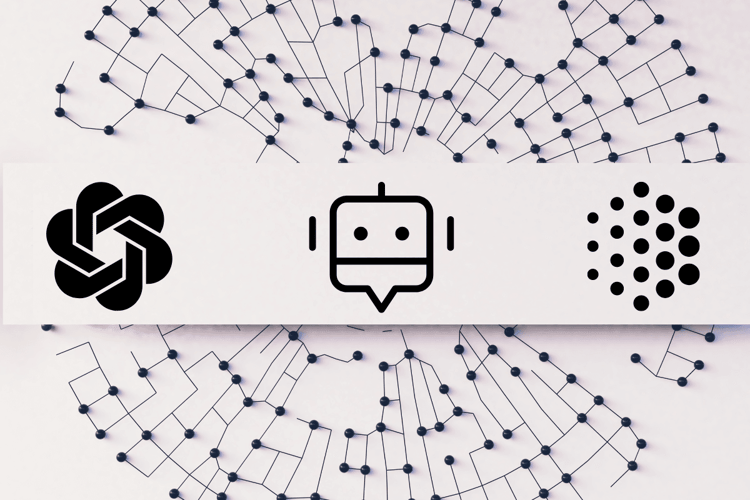Cursus

Following the recent releases of ChatGPT, GPT-4, BARD, and many other AI tools under the rubric of Generative AI, it seems that the world is on the brink of a technological revolution that will change nearly every sector of the economy forever.
Data science is no exception. Indeed, as the industry is directly involved in the development of AI, it’s not surprising that many of the recent AI breakthroughs will likely change the way data science is conceived today, reducing coding time and empowering data professionals to develop new, more advanced tools and AI models faster and more efficiently.
This article provides a list of the five most promising AI tools that are set to revolutionize data science. This is just the beginning, and AI tools are expected to join the vibrant data & machine learning tools landscape. But for now, let’s stick to the five best AI tools.
Why Use AI Tools?
Data influences decision-making processes across various industries, and the significance of AI tools in data science cannot be overstated. AI presents all kinds of advantages that cater to the needs of data scientists, analysts, and organizations at large.
First, they automate repetitive tasks, enabling professionals to allocate their time and resources toward more strategic data analysis and interpretation aspects.
Second, AI tools enhance accuracy and consistency in data handling, reducing the margin of human error and ensuring reliable outcomes. They facilitate data handling, extracting insightful patterns and predictions that are humanly impossible to discern.
Finally, AI can foster innovation by providing a platform for data scientists to experiment, optimize, and deploy models that drive actionable insights, steering organizations toward data-driven decision-making and strategic planning.
In addition to automating tasks and enhancing accuracy, AI tools contribute to data democratization by providing easy-to-use interfaces and APIs. This allows not only seasoned data professionals but also non-technical users to leverage advanced machine learning models, reducing the barriers to entry and enabling smaller organizations to harness AI’s potential.
AI Upskilling for Beginners
The Best AI Tools for Data Science
Navigating through the vast landscape of AI tools that have permeated the data science domain can be daunting. With their unique capabilities and applications, these tools have transformed traditional practices, introducing automation, precision, and enhanced predictive power into the data analysis pipeline.
Will AI replace programmers? As we explore in our separate article, it seems unlikely. However, it could mean a shift in working practices, where such tools become part of optimized workflows.
Here are some of the top AI tools available today:
1. ChatGPT
Developed by OpenAI and Microsoft, and publicly released for the first time in late 2022, ChatGPT surprised the world with its unique ability to generate human-like text of all kinds: code, poems, college-level essays, document summaries, and jokes. The list of possibilities offered by ChatGPT is infinite, which is why it is now the fastest-growing web application ever, reaching 100 million users in just two months.
GPT-4, the newest, safer, and more powerful version of ChatGPT, has already achieved incredible milestones, demonstrating human-level performance on various professional and academic benchmarks. Equally, it allows developers to build applications and services through the GPT4 API and a subscription plan called ChatGPT Plus.
In the field of data science, the possibilities of ChatGPT are endless, from project planning, data analysis, and data preprocessing, to model selection, hyperparameter tuning, and developing web applications. ChatGPT can help data professionals reduce coding times, allowing them to focus on more complex and imaginative problems.
If you want to know more about the potential of ChatGPT, we have prepared a tutorial on using ChatGPT for data science projects. Equally, if you want to get your hands dirty with the AI tool, we highly recommend you to check our Introduction to ChatGPT course, and our comprehensive Cheat sheet of ChatGPT prompts for data science, with over 60 examples of real-world uses of ChatGPT for data science.
2. Google Gemini
Following the release of ChatGPT, many people started to wonder what Google would do to address Microsoft's alleged existential threat. Microsoft has already incorporated ChatGPT into Bing, its own search engine.
It wouldn't take long for Google’s move. In February 2023, it announced the release of a new generative AI tool called Bard AI, powered by Google’s language model LaMDA. Bard was set to rival ChatGPT, however, the differences between the two AI tools were notorious at the beginning.
As of 2025, Bard has been remained to Gemini and has seen significant updates, improving its capabilities in code generation, integration with Google services, and access to real-time data. While Bard initially lagged behind ChatGPT, Gemini has quickly caught up, making it a strong alternative for data science tasks. Bard's ability to fetch real-time data from the web is especially useful for time-sensitive analyses.
3. Hugging Face
One of the most vibrant areas of data science is deep learning. AI tools like ChatGPT and Bard are powered by complex models called artificial neural networks, more precisely, a next-generation neural architecture called transformers.
Training transformers is a challenging task, that involves finding and storing the right amount data, and finding the necessary computational resources to train and operate the model. This is costly and time-consuming, and hence inaccessible for most people. Here is where Hugging Face joins the scene.
Hugging Face is an AI community and platform that aims to democratize AI by providing data practitioners access to over 170,000 pre-trained models based on state-of-the-art transformer architecture. Equally, Hugging Face comes with almost nearly 30.000 datasets and layered APIs (also called pipelines), that allow data professionals to interact with the models and perform inference using world-class AI libraries, like PyTorch, and TensorFlow. All without worrying about storage or training costs.
Hugging Face’s pre-trained models are widely used for tasks such as sentiment analysis, named entity recognition, and text classification. Additionally, Hugging Face offers AutoTrain, which allows users to automate the process of training models on custom datasets without needing deep technical expertise, saving time and resources.
Curious about transformers and Hugging Face? We highly recommend you check our Introduction to Using Transformers and Hugging Face tutorial.
4. GitHub Copilot
One of the greatest features of next-generation AI models is that you can fine-tune them on specific data, and build applications on top of them using APIs. A great example, with unpredictable implications for data science, and the IT industry in general, is GitHub Copilot.
GitHub Copilot is a programming assistant that provides coders with autocomplete suggestions. Built on top of the OpenAI Codex model, developers can use Copilot either while writing code, or by using basic natural language prompts that tell Copilot what they want the code to do.
Capable in a myriad of coding tasks, and proficient in a dozen popular programming languages, such as Python, Go, and JavaScript, GitHub Copilot opens the door for a new, more democratic way of programming, where, ironically, knowing how to code is no longer a mandatory prerequisite.
As a downside, and a possible drawback for its massive adoption, so far there isn’t a free version of GitHub Copilot available.
While GitHub Copilot is a powerful tool, alternatives like Tabnine and Codeium also make waves in the AI-assisted coding space. These tools support autocomplete and code generation in multiple languages, providing developers with more options depending on their specific needs or budget constraints.
5. DataLab AI Assistant
DataCamp has recently introduced an AI Assistant to its popular data science notebook, DataLab. Designed with data democratization in mind, DataLab initially gained traction among learners building portfolios for their data science careers. As it evolved, it became a valuable tool for team collaboration and organizational learning across various industries.
With the new AI Assistant, DataLab aims to make data science even more accessible and productive for its users. Key features of the AI Assistant include the "Fix Error" button, which not only corrects code errors but also explains them, allowing users to learn and avoid repeating mistakes. The “Generate Code” feature allows you to generate code based on natural language queries, and answer key questions about a dataset. Additionally, the AI Assistant provides intelligent suggestions based on existing code and context, making code writing smarter and more efficient.
Available on both free and paid DataLab plans, the AI Assistant promises a more seamless integration into the tooling stack of modern data scientists, empowering anyone working with data to make informed decisions. You can try it out here!
Conclusion
We hope you enjoyed this article. We’re living in exciting times to be data professionals. The industry is on the brink of disruption following the massive adoption of generative AI tools. It’s still too early to know what data science will look like in the coming years. The only certainty is that it’s smart to get tuned and updated.
As AI tools continue to evolve, the data science landscape will see even more disruptive trends, including advancements in autoML and LLMOps. These trends promise to automate not only data preprocessing and model selection but also the management and fine-tuning of large language models, further reducing the technical overhead for data scientists.
We at DataCamp are working hard to provide useful information and materials to navigate these unprecedented times. Check out the following materials and get ready for the future:
- Get started with ChatGPT in our Introduction to ChatGPT course.
- Download this handy reference cheat sheet of ChatGPT prompts for data science.
- Listen to this podcast episode on How ChatGPT and GPT-3 Are Augmenting Workflows to understand how ChatGPT can benefit your business.
- Tutorial on the Whisper API
- Start learning AI with DataCamp
Earn a Top AI Certification
FAQs
How can ChatGPT help data professionals?
In the field of data science, ChatGPT can help reduce coding times, allowing data professionals to focus on more complex and imaginative problems.
What is Hugging Face and how can it help data practitioners?
Hugging Face is an AI community and platform that aims to democratize AI by providing data practitioners access to over 170,000 pre-trained models based on state-of-the-art transformer architecture. Hugging Face also comes with almost 30,000 datasets and layered APIs, allowing data professionals to interact with the models and perform inference using world-class AI libraries like PyTorch and TensorFlow, without worrying about storage or training costs.
What is GitHub Copilot and how can it help coders?
GitHub Copilot is a programming assistant that provides coders with autocomplete suggestions built on top of the OpenAI Codex model. Developers can use Copilot either while writing code or by using basic natural language prompts that tell Copilot what they want the code to do. Capable in a myriad of coding tasks and proficient in a dozen popular programming languages, GitHub Copilot opens the door for a new, more democratic way of programming, where knowing how to code is no longer a mandatory prerequisite.
What is Bard AI and how does it compare to ChatGPT?
Bard AI is a generative AI tool developed by Google that is powered by Google's language model LaMDA. While it is set to rival ChatGPT, Bard is still in its infancy and is not yet optimized for coding tasks compared to ChatGPT. However, new improvements are expected in the future, and it's too early to determine a winner.
What is the DataLab AI Assistant and how can it help data scientists?
The AI Assistant was recently introduced to DataCamp's popular data science notebook, DataLab. It includes features like the "Fix Error" button, which not only corrects code errors but also explains them, and the "Generate Code" feature, which allows users to generate code based on natural language queries. Additionally, the AI assistant provides intelligent suggestions based on existing code and context, making code writing smarter and more efficient. Available on both free and paid DataKab plans, the AI assistant promises a more seamless integration into the tooling stack of modern data scientists, empowering anyone working with data to make informed decisions.

I am a freelance data analyst, collaborating with companies and organisations worldwide in data science projects. I am also a data science instructor with 2+ experience. I regularly write data-science-related articles in English and Spanish, some of which have been published on established websites such as DataCamp, Towards Data Science and Analytics Vidhya As a data scientist with a background in political science and law, my goal is to work at the interplay of public policy, law and technology, leveraging the power of ideas to advance innovative solutions and narratives that can help us address urgent challenges, namely the climate crisis. I consider myself a self-taught person, a constant learner, and a firm supporter of multidisciplinary. It is never too late to learn new things.


